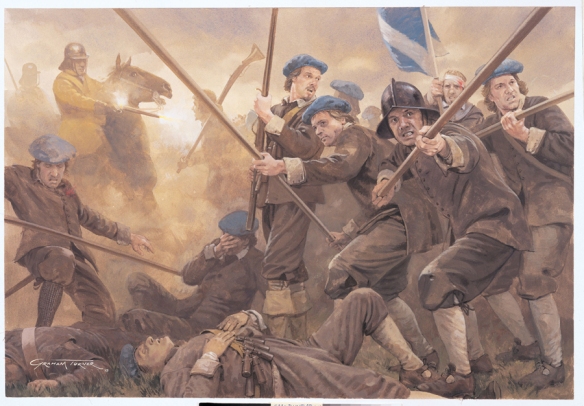Greatly helped by the battle -hardened nature of his army, Cromwell revealed his ability in both offence and defence in the Dunbar and Worcester campaigns.
Scottish quiescence was crucial to the early stages of the conquest of Ireland, but in 1650 Charles I’s eldest son, Charles II, came to terms with the Scots. In response, Cromwell invaded Scotland on 22 July 1650. Unable to breach the Scottish fortified positions around Edinburgh and outmanoeuvred by David Leslie, he retreated to Dunbar. Cromwell, cut off from retreat to England by a force twice the size of his own, launched a surprise attack which defeated the Scottish cavalry, while much of the infantry surrendered (3 September). Edinburgh was then captured.
Dunbar Campaign
With another war against Scotland now inevitable, Parliament decided to launch a pre-emptive strike. Fairfax declined the command, so it was left to Cromwell to lead the expedition which crossed the Scottish frontier on the 22 July 1650. His force was comprised of eight horse regiments and nine regiments of foot; some 16,000 men.
On 6 August, within a mile of Edinburgh, his progress was barred by David Leslie with an army of 22,000 men. Outnumbered, and outmanoeuvred, Cromwell was forced to fall back on Dunbar where he was blockaded by the Scots.
Leslie’s strategy was based on his awareness of the fact that, while he possessed superior numbers, his troops were not of the same quality as the veterans of the New Model Army. His intention was to remain outside Dunbar, on the impregnable Lammermuir Hills, and starve Cromwell into submission.
By September Cromwell’s army, ravaged by sickness, was down to 11,000 men. Trapped between the mountains and the sea, short of supplies and with winter coming on, he had good reason to be worried. He wrote gloomily to Sir Arthur Hesilrige that the New Model Army would require ‘a miracle’ in order to escape. Then the unexpected happened. The ministers of the Scottish Kirk, convinced they ‘had got God on their side’, compelled Leslie to abandon the blockade and launch an all-out attack.
At around 4 p.m. on the 2 September, Cromwell was surveying the enemy lines when he ‘discerned through his glass an extraordinary movement in the Scottish camp’. This cheered him up immensely. ‘They are coming down’ he exclaimed, ‘the Lord hath delivered them into our hands. ’68 That same night, in the utter darkness of a rainstorm which had blown in off the sea, he prepared a surprise attack. Cannons and dragoons were deployed to engage the Scottish left, while the bulk of the army filed across the deep Brox Burn ravine towards Leslie’s right wing.
The English vanguard went in before sunrise, spearheaded by General Lambert’s cavalry and seconded by General Monck with three infantry regiments. Although they were successfully contained by the Scottish horse, thundering down with their lancers in the front ranks, it was to no avail. Almost before the Scots could draw breath, Cromwell had put the second part of his plan into action. On the previous day he had noticed that Leslie’s right wing was so cramped for space between the mountains behind and the ravine in front, that they ‘had not great ground to traverse their regiments … [or] wheel about’.
Seizing upon this weakness, he now led his own cavalry regiment of Ironsides, together with a regiment of foot, in a crushing flank attack. Although some of the Scottish infantry put up a tenacious resistance, many were disordered by their own horse, which routed through their lines. Even as their embattled ranks began to crumble, the Presbyterian ministers among them continued to preach; assuring the Scots that God would grant them success, ‘ … till the English were upon them; and some of their preachers were knocked in the head whilst they were promising victory.
As Cromwell pushed forward, the morning sun suddenly broke through the clouds to bounce off a silvery sea. Inspired by this omen he cried out ‘Now let God arise, and his enemies shall be scattered’. Without ceasing the busy rhythm of their blades, his regiments pressed their flank attack steadily home, rolling up the Scottish right until at last Cromwell’s voice boomed out again: ‘I profess they run! ‘. Then as the last pockets of Scottish infantry ‘threw down their arms and fled’, he halted his men and sang the seventeenth psalm.
The worst of the fighting was over in about an hour. While the speed and lethal effectiveness of the English flank attack had preserved Cromwell’s army almost intact, 3,000 Scots were listed killed and 10,000 captured.
As Leslie’s soldiers tasted the bitter ashes of defeat, one Scottish preacher was to lament that Cromwell was worse than the Devil: ‘For the scripture said, Resist the Devil and he will flie from you – but resist Oliver and he will flie in your face.’
Worcester Campaign
In the following summer, Cromwell used his command of the sea to outflank the Scots at Stirling and occupied Perth, but Charles then marched south into England, hoping to ignite a Royalist rebellion. He reached Wigan on 15 August, but, short of recruits, decided to head for the Welsh Borders rather than march directly on London. Shrewsbury, however, resisted the Royalist advance, and when Charles reached Worcester on 22 August he had recruited few additional men. His opponents concentrated on Warwick on 24 August and then advanced on Worcester, winning a crossing over the Severn at Upton. The Parliamentarians under Cromwell, who numbered about 30,000 men, drove at Worcester on 3 September from several directions. The Royalists, with about 12,000, launched an initially successful frontal attack on Cromwell’s position, but numbers told and the Royalist army was overwhelmed. Hiding in an oak tree and supporters’ houses en route, Charles II fled to France, leaving the Royalist cause crushed. By the summer of 1652, all Scotland had fallen.
